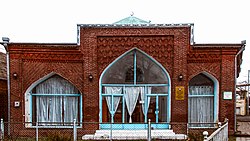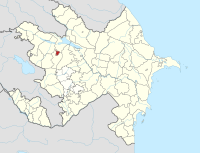The Ozan Mosque - ( Azerbaijani Ozan məscidi ) a mosque and historical-architectural monument built in 1884, located in the city of Ganja, Azerbaijan.
Ozan Mosque
Ozan məscidi | |
|---|---|
Mosque | |
 The Ozan Mosque located in the city of Ganja | |
 |
The mosque was included in the list of immovable historical and cultural monuments of local significance by Decision No. 132 of the Cabinet of Ministers of the Republic of Azerbaijan on August 2, 2001.
About
editOzan Mosque was built in 1884 in the city of Ganja at the expense of the residents of the Ozan neighborhood. [1][2] However, the inscription on the arch above the entrance states the construction date as 1786. [3][4] The total area of the building is 357.8 m², while the usable area is 223.8 m². The main part of the mosque is a square-shaped prayer hall covered by a dome. There are two auxiliary rooms on the sides.
In issue 12 of the "Molla Nasreddin" magazine from 1907, it was reported that 2,000 manats were collected in 1906 for the repair of the mosque with the help of residents of the Ozan neighborhood.[2] In 1920, during the Ganja uprising, part of the mosque was destroyed by cannon fire from the Bolsheviks who besieged the city. Additionally, during the suppression of the uprising, local residents who had taken refuge in the mosque were burned alive inside.[5] Mammad Altunbay, a military pilot and émigré originally from Ganja, personally witnessed the events in the mosque. He wrote about them in his book, published in Ankara in 1989. In his book, he notes that:
In the center of the Ozan Mosque, the charred bodies of hundreds of people twisted by the fire created a horrifying scene... The blood and fat of the innocent people burned alive flowed out from under the charred door. Among the corpses, there were faces, hands, feet, and braids that, though not completely burned, had turned black, further amplifying the immense horror of the tragedy. At the other end of the street, five or six Armenians were playing the accordion.
After the Soviet occupation of Azerbaijan, an official campaign against religion began in 1928.[6] In December of that year, the Central Committee of the Communist Party of Azerbaijan transferred many mosques, churches, and synagogues to the balance of clubs for educational purposes.[7] While there were 3,000 mosques in Azerbaijan in 1917, this number decreased to 1,700 in 1927, 1,369 in 1928, and only 17 by 1933.[7][8] Ozan Mosque was also closed to worship during this period. The building was initially used as a workshop for the blind and later as a grocery store.[2] In 1979, the mosque building was restored.[4] Paintings were created on its interior walls by artist Rustam Huseynquliyev. The building housed a Nizami memorial museum and a bookshop.[2]
After Azerbaijan regained its independence, the mosque was included in the list of immovable historical and cultural monuments of local significance by Decision No. 132 of the Cabinet of Ministers of the Republic of Azerbaijan on August 2, 2001.[9]
References
edit- ^ Məmmədov, Mərdan (2021). Gəncə abidələri (in Azerbaijani). Bakı: Azərnəşr. p. 32. Archived from the original on 2024-09-18. Retrieved 2024-09-17.
- ^ a b c d Əhmədov, Fərrux (1998). Gəncənin tarix yaddaşı (in Azerbaijani). Bakı: Şirvannəşr. p. 158. Archived from the original on 2024-09-18. Retrieved 2024-09-18.
- ^ "Gəncə şəhəri Ozan məscidi". sirat.az. 2022-03-14. Retrieved 2024-09-18.
- ^ a b "Gəncə Daşların yaddaşı - Ozan məscidi". Trend.Az (in Azerbaijani). 2020-03-13. Archived from the original on 2024-05-30. Retrieved 2024-09-18.
- ^ Gəncənin maddi mədəniyyət abidələri (in Azerbaijani). Bakı: Nurlan. 2004. p. 61. Archived from the original on 2024-09-19. Retrieved 2024-09-19.
- ^ Yunusov, Arif (2004). Azərbaycanda İslam (PDF) (in Azerbaijani). Bakı: Zaman. p. 140. ISBN 9952-8052-2-5. Archived (PDF) from the original on 2023-07-05. Retrieved 2022-12-14.
- ^ a b Yunusov, Arif (2004). Azərbaycanda İslam (PDF) (in Azerbaijani). Bakı: Zaman. p. 141. ISBN 9952-8052-2-5. Archived (PDF) from the original on 2023-07-05. Retrieved 2022-12-14.
- ^ Ələsgərova, Nəsrin (2005-01-15). "Ислам в Азербайджане: история и современность | Heinrich Böll Stiftung | Tbilisi - South Caucasus Region". ge.boell.org (in Russian). Archived from the original on 2019-09-13. Retrieved 2024-09-04.
- ^ "Azərbaycan Respublikası Nazirlər Kabinetinin 2001-ci il 2 avqust Tarixli 132 nömrəli qərarı ilə təsdiq edilmişdir" (PDF) (in Azerbaijani). mct.gov.az. 2001-08-02. Archived from the original (PDF) on 2021-07-07. Retrieved 2022-12-14.
- ^ Hacıyev, Rauf (2016-05-18). "Ozan məscidi: Qanlı tarixin daş yadigarı". Azərbaycan Dövlət İnformasiya Agentliyi. Retrieved 2024-09-18.
- ^ "Gəncənin qanlı tarixinin lal şahidi: Ozan məscidi". gencexeber.az (in Azerbaijani). 2021-08-13. Archived from the original on 2024-09-19. Retrieved 2024-09-18.
